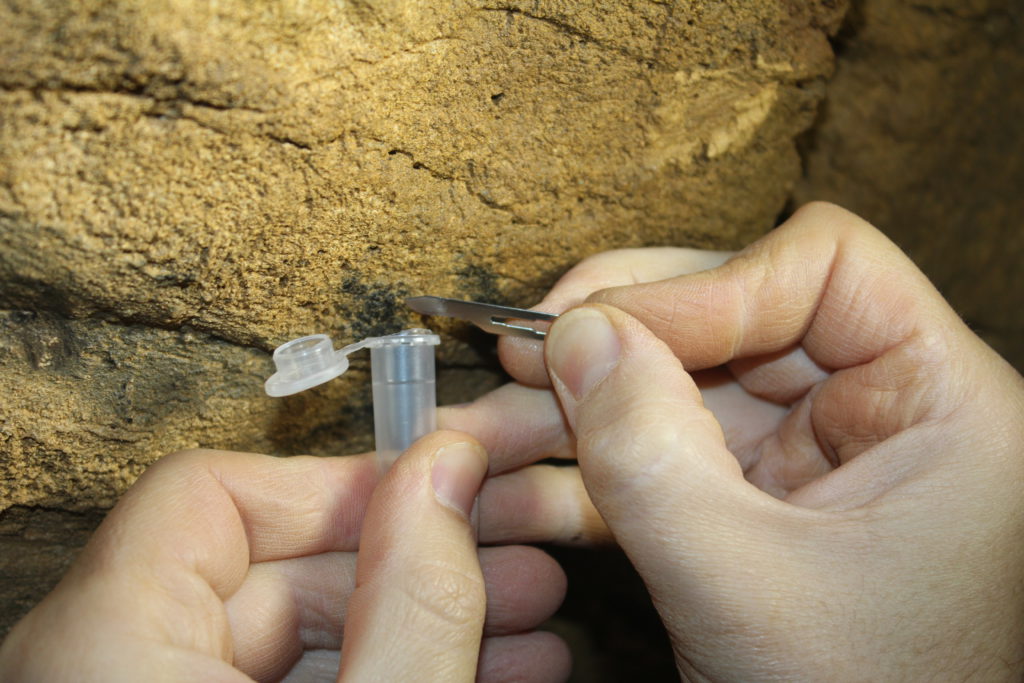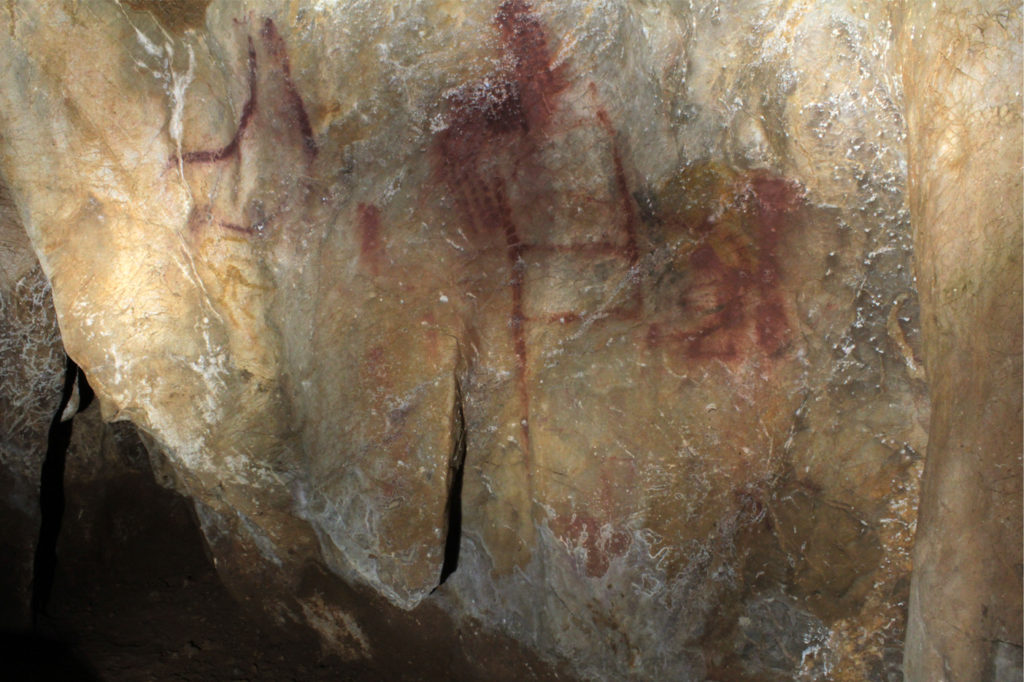Cave art is one of the first expressions of human symbolic behaviour. It has been described as one of our trade marks as Anatomically Modern Humans (Homo sapiens) and it is something that, up to days ago, defined us as a species. However, we recently learned that Neanderthals had some kind of symbolic behaviour, though its extent is still largely unknown. So how do archaeologists know the age of the cave paintings in places like Altamira or Lascaux? We cannot use the usual tools applied in other archaeological fields, so we have to rely on different methods to determine when they were made (and in turn by whom!).

Radiocarbon sampling
Broadly speaking, Palaeolithic cave art appeared around 40,000 years ago and continued until 12,000 years ago. It persisted, with ups and downs, for at least 28,000 years. If we compare this extension to long-lasting artistic trends in Western Europe, Romanesque art lasted only for about 300 years and some more recent trends only lasted a decade. Palaeolithic cave art mainly comprises animal depictions and signs that were drawn or engraved in the walls, ceilings and even the floors of the caves. Its purpose and use are largely unknown and even though researchers have created theories to ‘explain’ it, none can be proven at this point. The art was created both in accessible places and in very remote areas. Some panels, like the famous images at Lascaux were meant to be looked at by an audience; others were clearly intended to be hidden as they are placed in small, hard to reach, places. Looking at some of the most well-known examples –such as Altamira, Ekain, Lascaux, Chauvet– we can see differences in style but also similarities. These might be explained by different purposes of the art, cultural segregation and also evolution in a chronological sense, and so can help provide some clues to the age of the art.
As cave art is placed on walls, it is difficult to apply the dating methods that other archaeologists usually use: the deeper an object is found, the older it is. The pioneers in cave art research developed two new methods based on archaeological assumptions but also on History of Art techniques. On one hand, they compared what they saw on the cave walls to pieces of art of known age found in excavations. On the other, they used a technique called ‘parietal stratigraphy’. Where figures of different styles were found overlapping each other, those underneath could be assumed to be older than the figures on top. These two methods are largely based on the study of style and the characteristics of the figures, as applied in History of Art: Picasso’s works are not in the same style as Goya’s. Even though these methods might seem rudimentary, they were the only way to date cave art until 25 years ago. The original framework developed from stylistic analysis was refined as new dating techniques were applied to artefacts found in excavations, allowing us to have a more precise image of portable art, but we still lacked a way of dating the cave art.
By the early 90s radiocarbon dating methods had evolved enough to process very small samples. Radiocarbon dates the presence of C14, an unstable radioactive isotope present in organic materials –trees, animals, humans, etc–. Once the organism dies, it stops acquiring this molecule and it starts disintegrating at a fixed rate. Analysing how much C14 is left in a sample allows to know when the original organism died. In the case of cave art, it meant that figures drawn with charcoal –made out of burnt tree branches– could be dated. However, this method (still) has some problems in the grand scheme of things: only about a third of all of the depictions were created with black pigments, and not all of those are made with charcoal. Also, the technique was very new and the results obtained had to be taken with a ‘pinch of salt’. This meant that some advances could be made, but at the same time, we had to be careful and apply scientific reason to interpret the dates.

Oldest dated depiction (rectangle). La Pasiega cave, Cantabria (Spain)
In the last decade, a new method to date cave art was developed: Uranium series dating. It is based on another radioactive isotope and it works, in general terms, as Radiocarbon does, but it dates calcite. Calcification is the geological process that occurs in caves creating stalagmites and stalactites, but it also appears on the walls, sometimes growing over the drawings and engravings. And that is where the samples are taken from. The date obtained is for the calcite, not for the art but we know that the underlying drawing must be older than this. In theory, it gives us the latest possible date that any depiction might have been made before it was covered by calcite – but can only be used for art affected in this way.
The development of new methods helps but it also created new problems. Not a bad thing in research! Until these new methods came into the picture, most researchers followed the general trend that started at the beginning of the 20th century. The new results stirred the pot, generating debate. An example is Chauvet cave, discovered in 1994. It displays some of the most intricate and elaborate panels in all Western European Palaeolithic cave art. Originally thought to be of the last phases of the Upper Palaeolithic at around 15,000 years, some figures, bones and charcoal on the floor were dated and the results surprised everyone at 33,000 years! From then onwards it was argued to be one of the oldest forms of art modern humans produced. Nonetheless, some unresolved chemical and archaeological problems with the dates generated a heated debate between researchers that continues even after 15 years.
Both C14 and U-Series dating depend on many variables so archaeologists, geologists and chemists need to collaborate closely in this endeavour. At this point, both methods have proven to be invaluable tools to help us dating the development of cave art, but we cannot completely rely on them for various reasons: their application to cave art is very new and we need to refine the methodology; we still do not have enough dates, and we need to carefully examine the few we have in an archaeological perspective; and more importantly, because most of the art was not created with charcoal or does not have calcite formations over it, we are never going to be able to date everything. Therefore, even though we have a ‘scientific’ way to date cave art, we must still rely on the old and flawed dating methods such as stylistic comparisons. The goal is to use all methods to create a solid framework to understand the evolution of the Palaeolithic societies and maybe even get to know the purpose of the art in deep caves. Who knows!
By Dr Blanca Ochoa Fraile Basque Government Research Fellow, Durham University / University of the Basque Country. SRUK North Easth Constituency.






